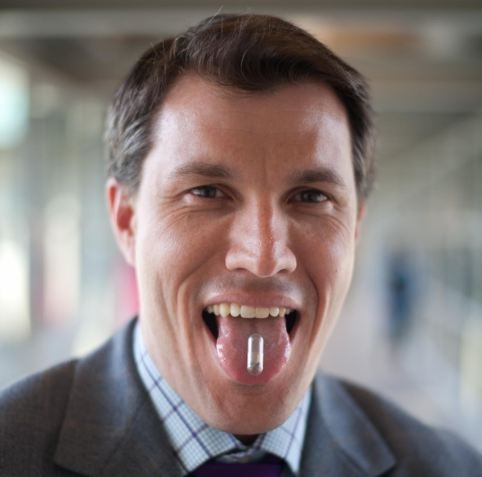Batteries You can Eat will Power Future Ingestible Medical Devices
| Arthur Dominic Villasanta | | Aug 24, 2016 07:26 AM EDT |
(Photo : Bettinger lab) Christopher Bettinger and his team are developing an edible battery made with melanin and dissolvable materials.
Non-toxic, edible batteries made with melanin pigments naturally found in the skin, hair and eyes might one day power ingestible devices for diagnosing and treating disease.
A team of researchers from at Carnegie Mellon University (CMU) reported new progress toward this goal with batteries that minimize the potential harm of ingestible devices. The team led by Christopher Bettinger, Ph.D. decided to turn to melanins and other naturally occurring compounds to build this edible battery.
Like Us on Facebook
In our skin, hair and eyes, melanins absorb ultraviolet light to quench free radicals and protect us from damage. They also happen to bind and unbind metallic ions.
"We thought, this is basically a battery," said Bettinger.
"For decades, people have been envisioning that one day, we would have edible electronic devices to diagnose or treat disease," said Bettinger.
"But if you want to take a device every day, you have to think about toxicity issues. That's when we have to think about biologically derived materials that could replace some of these things you might find in a RadioShack."
Building on this idea, the researchers experimented with battery designs that use melanin pigments at either the positive or negative terminals; various electrode materials such as manganese oxide and sodium titanium phosphate and cations such as copper and iron that the body uses for normal functioning.
"We found basically that they work," says Hang-Ah Park, Ph.D., a post-doctoral researcher at CMU.
"The exact numbers depend on the configuration, but as an example, we can power a 5 milliWatt device for up to 18 hours using 600 milligrams of active melanin material as a cathode."
Although the capacity of a melanin battery is low compared to lithium-ion, it would be high enough to power an ingestible drug-delivery or sensing device.
Bettinger envisions using his group's battery for sensing gut microbiome changes and responding with a release of medicine, or for delivering bursts of a vaccine over several hours before degrading.
In parallel with the melanin batteries, the team is also making edible batteries with other biomaterials such as pectin, a natural compound from plants used as a gelling agent in jams and jellies. Next, they plan on developing packaging materials that will safely deliver the battery to the stomach.
When these batteries will be incorporated into biomedical devices is uncertain, but Bettinger has already found another application for them. His lab uses the batteries to probe the structure and chemistry of the melanin pigments themselves to better understand how they work.
"The beauty is that by definition an ingestible, degradable device is in the body for no longer than 20 hours or so," said Bettinger. "Even if you have marginal performance, which we do, that's all you need."
Tagsedible batteries, melanin, Carnegie Mellon University, Christopher Bettinger
©2015 Chinatopix All rights reserved. Do not reproduce without permission
EDITOR'S PICKS
-

Did the Trump administration just announce plans for a trade war with ‘hostile’ China and Russia?
-

US Senate passes Taiwan travel bill slammed by China
-

As Yan Sihong’s family grieves, here are other Chinese students who went missing abroad. Some have never been found
-

Beijing blasts Western critics who ‘smear China’ with the term sharp power
-

China Envoy Seeks to Defuse Tensions With U.S. as a Trade War Brews
-

Singapore's Deputy PM Provides Bitcoin Vote of Confidence Amid China's Blanket Bans
-

China warns investors over risks in overseas virtual currency trading
-

Chinese government most trustworthy: survey
-

Kashima Antlers On Course For Back-To-Back Titles
MOST POPULAR
LATEST NEWS
Zhou Yongkang: China's Former Security Chief Sentenced to Life in Prison

China's former Chief of the Ministry of Public Security, Zhou Yongkang, has been given a life sentence after he was found guilty of abusing his office, bribery and deliberately ... Full Article
TRENDING STORY

China Pork Prices Expected to Stabilize As The Supplies Recover

Elephone P9000 Smartphone is now on Sale on Amazon India

There's a Big Chance Cliffhangers Won't Still Be Resolved When Grey's Anatomy Season 13 Returns

Supreme Court Ruled on Samsung vs Apple Dispute for Patent Infringement

Microsoft Surface Pro 5 Rumors and Release Date: What is the Latest?













